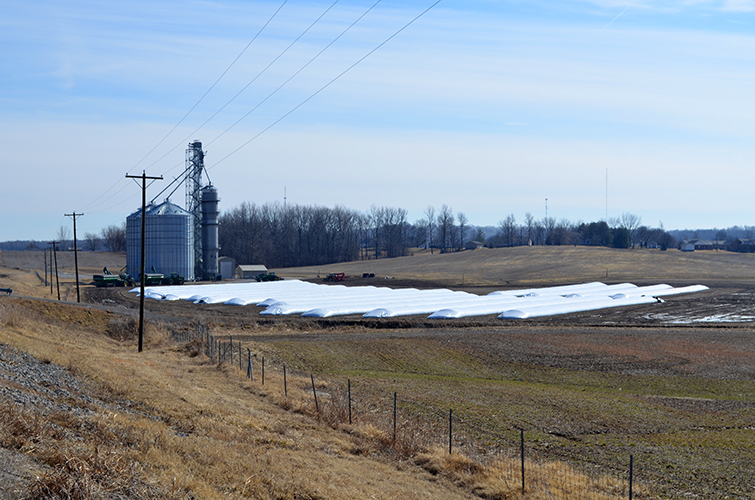Grain markets favor storage; alternative structures likely option
Grain markets favor storage; alternative structures likely option

Continuous years of large crops and demand uncertainty makes grain storage attractive for producers this fall. While Kentucky producers have added on-farm storage to their operations in recent years, many will store corn and soybeans in alternative structures through the winter, particularly as markets are showing positive returns.
“Higher futures prices in spring 2019 and a wide basis are classic market signs for storage,” said Todd Davis, agricultural economist in the University of Kentucky College of Agriculture, Food and Environment. “Given the current futures carry and average basis appreciation after harvest, the net return for storing corn until February is $0.19 per bushel and $0.29 a bushel for storage until May. Soybeans should have a net return of $0.45 per bushel if held until January and $0.57 per bushel return in May. This return is over the opportunity cost of not selling grain at harvest.”
The U.S. Department of Agriculture's September crop report predicts a U.S. corn crop of 14.8 billion bushels. If realized, it would be the second largest crop on record. The report puts soybean production at 4.6 billion bushels. Projections for Kentucky are 214 million bushels for corn and 119 million bushels for soybeans, according to the Kentucky Agricultural Statistics Service. Kentucky producers grew about 3 million fewer bushels of corn compared to last year, but they have raised 16 million more bushels of soybeans than last year.
Alternative storage structures have become more common across the state in recent years as producers hold larger amounts of grain in anticipation of better marketing opportunities. Equipment storage buildings, grain bags and covered outdoor piles are some of the more common alternative storage structures.
Producers who plan to store grain in alternative structures need to keep a watchful eye.
“A producer’s job really isn’t done until grain has passed grade at the elevator and is sold,” said Sam McNeill, UK extension agricultural engineer. “The diligence spent scouting fields during the growing season should transfer to managing stored grain."
If producers properly dry and cool grain, protect it from pests, aerate and regularly inspect it, it will store well with little chance of excess spoilage, which will help prevent potential price docks when delivered for sale. Clean, undamaged grain is best for temporary storage when farmers use less-than-ideal facilities. Producers should aim for 14 percent moisture content for corn and 12 percent for soybeans that will be stored in alternative structures through February. If held through May, producers should reduce these levels by 0.5 to one point of moisture to compensate for warmer temperatures. Producers should thoroughly clean storage sheds before putting grain in them, and they need to fill all temporary structures last and empty them first.
A properly designed aeration system is essential for successful grain storage and is the key to maintaining uniform temperatures, which control moisture accumulation and subsequent grain spoilage. Producers should run aeration fans at least once a month in flat storage buildings and continuously in covered piles to hold down the cover.
Producers should routinely monitor grain held in alternative storage structures for damage from rodents, birds and insects. These structures are at greater risk for damage due to inherent exposure. Producers should address any issues quickly with approved pest control methods.
Alternative storage costs vary widely depending on the type of structure, its original condition and holding capacity. Farmers can use a spreadsheet available on the UK Department of Biosystems and Agricultural Engineering website, https://www.uky.edu/bae/grain-storage-systems/, to estimate the amount of grain these types of structures can hold. They can enter the dimensions of the structure, pile or bag to calculate storage capacity in bushels. The UK Cooperative Extension Service also has a recent publication, ID-249: A Comprehensive Guide to Soybean Management in Kentucky, which includes chapters on production economics and post-harvest management. County extension offices have additional information on managing stored grain in bins or alternative structures.
Crops Economics Extension


